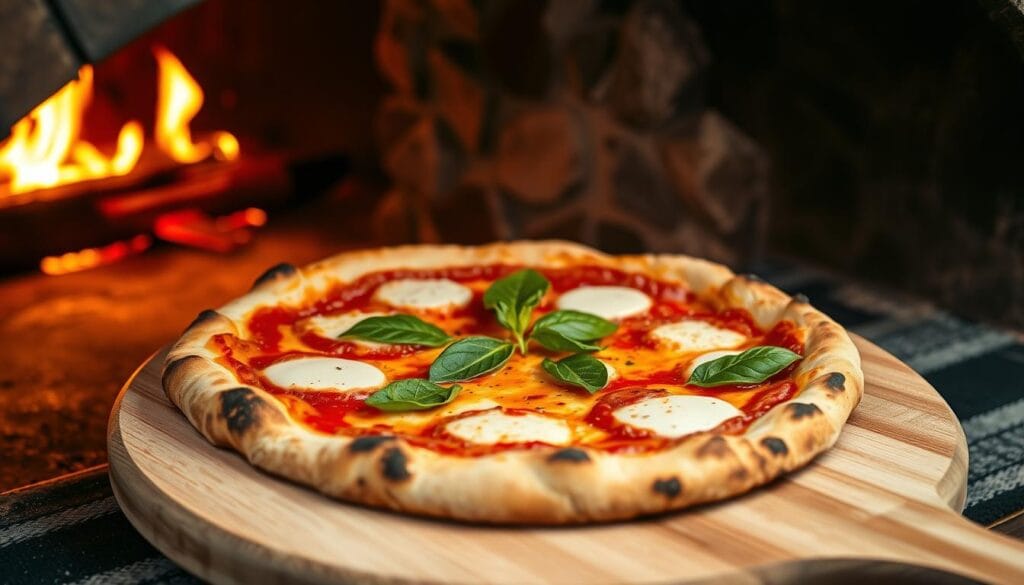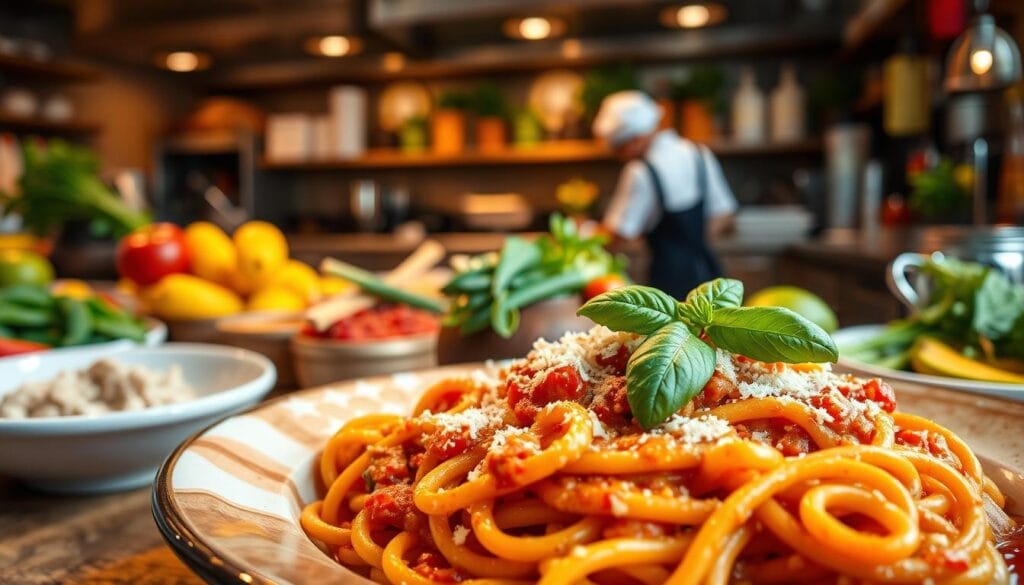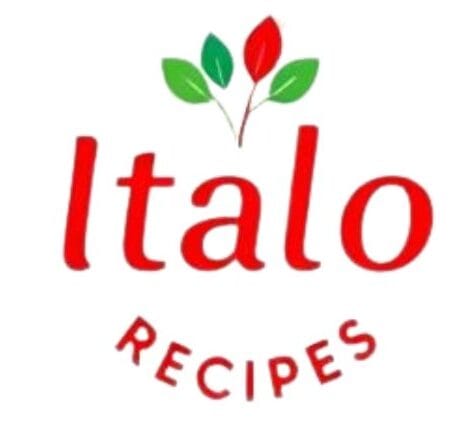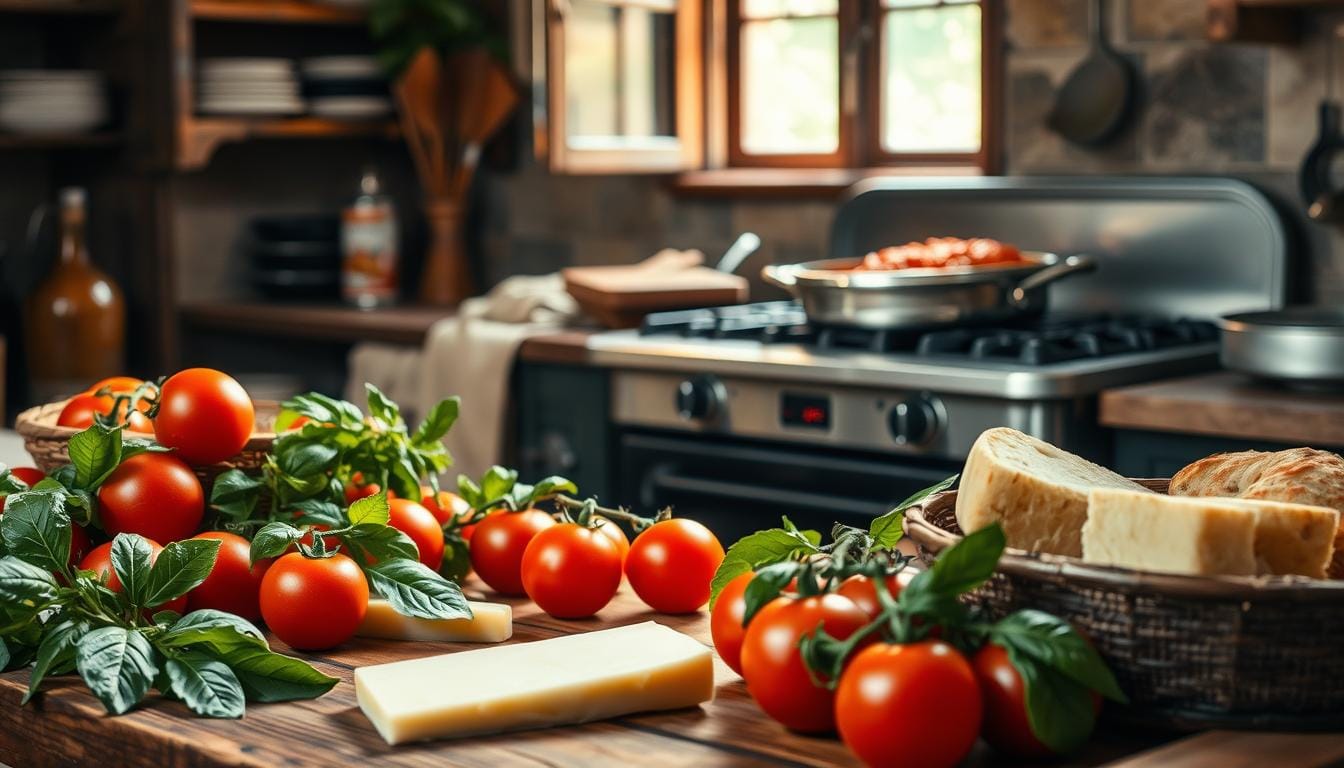The Secret of Italian Cuisine and Its Global Success in 2025
Have you ever enjoyed the rich tastes of Italian culinary traditions in a cozy trattoria or your kitchen? Italian food has become a hit all over the world. It wins over food lovers with its deep flavors and scents.
The charm of Italian cuisine history comes from its simplicity, fresh ingredients, and deep cultural roots. As you dive into Italian cooking, you’ll see why it’s loved everywhere. You’ll learn about regional differences, key ingredients, and cooking methods.
Table of Contents
Key Takeaways
- Italian cuisine is famous for its rich cultural background and fresh ingredients.
- The simplicity of Italian cooking makes it appealing worldwide.
- Regional differences are key in Italian culinary traditions.
- Important ingredients and cooking techniques are vital to Italian food.
- Italian cuisine is now a big part of global food culture.
The Rich History of Italian Cuisine
The story of Italian cuisine is filled with evolution. It was shaped by many cultural influences and local ingredients. Starting from ancient Rome, it has grown into the diverse culinary tradition we know today.
Exploring Italian cuisine’s history shows its rich regional diversity. Each region in Italy has its own special ingredients, cooking methods, and dishes. This variety adds to the complexity and richness of Italian food.
Regional Variations Across Italy
Italy’s geography is diverse, from the Alps in the north to the Mediterranean coast in the south. This variety has led to different regional cuisines. For example, the north is known for rich risottos and polentas, while the south is famous for spicy tomato sauces and fresh seafood.
Food historian notes, « The regional variations in Italian cuisine are a reflection of the country’s history, geography, and cultural heritage. » This diversity makes Italian cuisine so rich and varied.
Influences from Other Cultures
Italian cuisine wasn’t developed alone; it was influenced by many cultures. The Arabs introduced eggplants and citrus fruits, now common in Italian dishes. The New World discoveries brought tomatoes, potatoes, and corn, greatly impacting Italian cuisine.
« Italian cuisine is not just about food; it’s about the culture, the tradition, and the family. »
Understanding these influences helps us appreciate the complexity and depth of Italian culinary traditions. The mix of different cultures and ingredients has created a unique and flavorful cuisine enjoyed globally.
Key Ingredients of Italian Cooking
Italian cuisine is famous for using fresh, top-quality ingredients. These ingredients make simple dishes into works of art. A few well-chosen ingredients can change your cooking for the better.
The Role of Fresh Produce
Fresh produce is key in Italian cooking. It gives the flavors and smells that make Italian dishes special. Tomatoes, basil, garlic, and lemons are common in Traditional Italian recipes.
Using seasonal produce makes your cooking even better. For example, ripe tomatoes in summer sauces or fresh basil in pesto can really boost the taste of your Italian dishes.
Importance of Quality Olive Oil
Olive oil is vital in Italian cooking, used a lot in Italian culinary techniques. The quality of olive oil greatly affects a dish’s flavor. It’s important to pick a high-quality, extra virgin olive oil for the best taste and health benefits.
In Traditional Italian recipes, olive oil is used for sautéing, dressing salads, and as a finishing touch. When choosing olive oil, consider the region and production methods for the best flavor.
Authentic Italian Cheeses
Cheese is crucial in Italian cooking, with many cheeses used across different regions. Parmigiano Reggiano, Mozzarella, and Gorgonzola are iconic Italian cheeses. Each cheese adds its own flavor and texture to dishes.
Try different cheeses to find the perfect match for your recipes. For instance, Parmigiano Reggiano adds a salty, umami flavor to pasta. Mozzarella is great for pizzas and caprese salads. Knowing the characteristics of these cheeses can help you master Italian culinary techniques.
The Emphasis on Simplicity
Italian cuisine is known for its simple cooking style. It focuses on the quality of ingredients rather than complicated recipes. This simplicity is key to Italian culinary traditions, where each ingredient is celebrated.
Italian cooking uses minimalist cooking techniques. Grilling, roasting, and sautéing are common. These methods let the natural flavors of ingredients stand out. This is seen in many popular Italian dishes, where a few top-quality ingredients make a tasty meal.
Minimalist Cooking Techniques
Italian cooking often uses simple yet effective methods. For example, grilling vegetables and meats brings out their natural tastes. Roasting also enhances the sweetness of vegetables and the depth of meats, showing the beauty of Italian food culture.
- Grilling: Enhances natural flavors
- Roasting: Brings out sweetness and depth
- Sautéing: Quickly cooks ingredients while preserving their texture
These techniques are easy to learn. They help home cooks make authentic Italian dishes with little effort.
Focusing on Flavor, Not Complexity
The heart of Italian cuisine is its focus on flavor, not complexity. Using a few, high-quality ingredients lets the natural tastes shine. This shows the richness of Italian culinary traditions, where simplicity and flavor are key.
« The discovery of a new dish does more for human happiness than the discovery of a new star. » – Jean Anthelme Brillat-Savarin
This quote captures the joy of Italian cooking. It’s about the simplicity and authenticity of the dishes.
Exploring Italian cuisine shows that simplicity is more than just cooking techniques. It’s about valuing ingredients and the joy of sharing meals. This simplicity is why Italian cuisine is loved worldwide.
Iconic Dishes that Define Italian Cuisine

Italian cuisine is known for a few dishes that have made it famous worldwide. These dishes are simple yet full of flavor and history. They have made Italian food a favorite around the globe.
Pizza: A Global Phenomenon
Pizza is a big hit from Italy, especially from Naples. It has grown to include many toppings and cooking styles. Now, pizza is found everywhere, from the classic margherita to new and exciting toppings.
Pizza is loved for its flexibility. You can choose from classic or try something new. Its popularity shows how Italian food can adapt and win hearts everywhere.
Pasta: A Versatile Staple
Pasta is a key part of Italian food, with many shapes and flavors. You can have spaghetti carbonara or fettuccine Alfredo. Pasta goes well with a variety of sauces, from simple olive oil to rich meat ragùs.
- Variety of Shapes: Pasta comes in many shapes, each perfect for different sauces and cooking ways.
- Regional Specialties: Italy’s regions have their own pasta dishes, showing off local ingredients and traditions.
Risotto: Creamy Comfort
Risotto is a creamy dish loved by many. It’s made with Arborio rice and cooked slowly with broth, often with mushrooms, asparagus, or seafood. The constant stirring makes it creamy.
For a great risotto, use the best ingredients and be patient. The result is a dish that highlights Italian cooking at its best.
The Importance of Family and Tradition
Italian cooking is all about family traditions and cultural heritage. It’s not just about food; it’s about the love and tradition in every dish.
Family is key in Italian cooking. Recipes are shared across generations, with each adding their own twist. This keeps Italian cuisine true to its roots and strengthens family ties.
Recipes Passed Down Through Generations
Italian cooking is simple and traditional. Many families have old recipe books filled with secrets and techniques passed down through the years.
- Traditional sauce recipes
- Pasta-making techniques
- Regional specialties
These recipes are more than just recipes. They connect us to our past and honor our heritage.
Sharing Meals as a Cultural Practice
In Italy, mealtimes are special. Sharing a meal is a cultural act that brings people together. Whether it’s a family dinner or a get-together with friends, food is at the heart of it all.
« La dolce far niente » – the joy of doing nothing – is found at the dinner table. Here, conversations flow as freely as the wine.
| Cultural Practice | Description | Significance |
|---|---|---|
| Family Dinners | Regular gatherings for meals | Strengthens family bonds |
| Festive Celebrations | Special meals during holidays | Celebrates heritage and tradition |
| Social Gatherings | Meals with friends and community | Fosters social connections |
Exploring Italian cuisine shows how important family and tradition are. It’s what makes it so unique and loved around the world.
Italian Cuisine’s Adaptation Worldwide

Italian cuisine has spread far and wide, adapting to new places. It has been welcomed and changed by various cultures. This has created a rich mix of flavors and dishes.
Italian food’s history shows its ability to fit into local tastes and cooking styles. It’s loved everywhere from the Americas to Asia. Chefs around the world have made it their own, showing off their creativity.
American Italian-American Cuisine
In the United States, Italian-American cuisine has become a big part of the food scene. Italian immigrants brought their cooking traditions here. They mixed these with local tastes, creating dishes like spaghetti and meatballs and chicken parmesan.
Italian-American food is a mix of cultures, showing how Italian cooking can change. Chefs use local ingredients and methods, making it appealing to many.
Fusion Dishes Gaining Popularity
Fusion dishes that blend Italian flavors with others are also popular. For example, Italian-Mexican fusion brings together pasta tacos. Italian-Asian fusion combines sushi with Italian ingredients. These dishes show how Italian cuisine keeps evolving.
| Fusion Cuisine | Example Dishes | Key Ingredients |
|---|---|---|
| Italian-Mexican | Pasta Tacos, Italian Quesadillas | Pasta, Tortillas, Mozzarella |
| Italian-Asian | Sushi with Italian Fillings, Ramen with Italian Sausage | Sushi Rice, Italian Sausage, Soy Sauce |
Italian cuisine keeps leading the way in the world of food. It adapts and innovates with new tastes and methods. This mix of old and new ensures Italian food will always be exciting and inspiring.
The Role of Italian Cuisine in Global Gastronomy
Italian cuisine is a big hit around the world. You can find its flavors in many places, from old-school restaurants to new, mixed dishes.
Italian restaurants are everywhere, from big cities to small towns. They bring Italy’s real tastes to people everywhere.
Italian Restaurants Around the World
In places like the U.S. and Australia, Italian food is a big deal. You can pick from cozy spots to fancy places, each with its own Italian twist.
Favorite dishes like pizza, pasta, and risotto are loved everywhere. They come with local flavors and creative spins.
| Popular Italian Dishes | Common Ingredients | Regional Variations |
|---|---|---|
| Pizza | Tomato sauce, mozzarella, basil | Neapolitan, Roman, Sicilian |
| Pasta | Spaghetti, carbonara sauce, parmesan | Carbonara, Bolognese, Pesto |
| Risotto | Arborio rice, white wine, parmesan | Mushroom, Seafood, Asparagus |
Celebrations of Italian Food Culture
Italian food culture is celebrated in many ways. You can join Italian food festivals, cooking classes, and workshops to dive into Italian cuisine.
These events show off Italian dishes and their cultural value. You’ll learn about cooking traditions, local specialties, and the joy of family meals.
Food and Wine Pairing in Italian Dining
Italian culinary traditions focus on pairing regional wines with local dishes. This pairing makes the dining experience better, highlighting the flavors of both food and wine. Learning about wine pairing can make you appreciate Italian cuisine more.
Regional Wines that Complement Dishes
Italy is famous for its many regional wines, each matching the local food. For example, a Tuscan Sangiovese goes great with meat dishes. A crisp Pinot Grigio from the Veneto region is perfect for seafood and salads. Knowing these pairings helps you choose the right wine for your meal.
- Barolo and Barbaresco from Piedmont, ideal with rich meat dishes and truffles.
- Chianti from Tuscany, pairs well with pasta dishes featuring tomato sauce and grilled meats.
- Moscato d’Asti, a sweet and sparkling wine from Piedmont, perfect for desserts or as an apéritif.
Tips for Perfect Pairings
To find the perfect pairing, think about the dish’s main flavors and the wine’s characteristics. Match the wine’s weight to the food’s weight. For example, a light white wine goes well with delicate fish, while a rich red wine suits hearty meat dishes.
- Consider the sauce: Tomato-based sauces pair well with medium-bodied reds like Chianti.
- Think about the ingredients: Dishes with seafood often pair nicely with crisp whites like Vermentino.
- Don’t forget the cheese: Aged cheeses like Parmigiano-Reggiano are complemented by sweet wines like Moscato.
Exploring Italian wine and cuisine, remember that taste is personal. Feel free to try new pairings and find what you like. The art of pairing Italian food and wine makes every meal special, celebrating flavor and culture.
The Health Benefits of Traditional Italian Diet
The traditional Italian diet is famous for its health perks. It focuses on fresh ingredients and follows Mediterranean diet rules. This diet is good for your health, making it popular for those wanting to eat better.
Mediterranean Diet Principles
The Italian diet is based on the Mediterranean diet. It’s full of fruits, veggies, whole grains, and healthy fats like olive oil. These foods are great for your heart, lowering the risk of heart disease and stroke.
It’s all about eating whole, unprocessed foods. Italians eat lots of seasonal fruits and veggies, packed with vitamins and antioxidants. They also have dairy, fish, and poultry in moderation, for a balanced diet.
| Dietary Component | Health Benefit |
|---|---|
| High Consumption of Fruits and Vegetables | Rich in Vitamins, Minerals, and Antioxidants |
| Use of Olive Oil | Reduces Heart Disease Risk |
| Whole Grains | Provides Fiber, Reducing Risk of Chronic Diseases |
Emphasis on Fresh Ingredients
The Italian diet loves fresh, seasonal ingredients. Eating what’s in season means getting the best, most nutritious foods. It makes meals taste better and are healthier too.
Also, making meals from scratch lets you choose what goes in. This means less processed and salty foods. It helps you eat better and more balanced.
In short, the traditional Italian diet is a great example of healthy eating. It’s based on Mediterranean diet rules and uses only the best ingredients. Following this diet can help prevent chronic diseases and improve your health.
How Italian Cuisine Inspires Home Cooking
Italian cuisine focuses on fresh ingredients and simple techniques. This makes cooking at home easier than ever. Italian dishes, with their rich flavors and aromas, are now common in kitchens worldwide.
Cooking classes on Italian dishes inspire home cooks. These classes teach the techniques and ingredients for authentic Italian meals. You get hands-on experience with traditional recipes.
Cooking Classes Focused on Italian Dishes
Cooking classes on Italian cuisine offer a chance to learn from chefs. They cover topics from basic pasta-making to complex risotto recipes. It’s a great way to improve your cooking skills.
« The art of cooking is not just about preparing food, it’s about creating an experience that brings people together. » –
Some popular cooking classes include:
- Pasta-making workshops
- Risotto and risotto variations
- Italian dessert-making classes
Accessible Recipes for Beginners
For beginners, there are many easy Italian recipes. Simple dishes like spaghetti aglio e olio or margherita pizza are perfect for starting. They introduce you to Italian flavors and basic cooking techniques.
| Dish | Main Ingredients | Cooking Time |
|---|---|---|
| Spaghetti Aglio e Olio | Spaghetti, garlic, olive oil | 15 minutes |
| Margherita Pizza | Pizza dough, tomatoes, mozzarella | 20 minutes |
These recipes are great for beginners. They teach you basic cooking techniques. You can apply these skills to many dishes.
Exploring Italian cuisine through classes and simple recipes is rewarding. Home cooks can improve their skills and enjoy Italy’s flavors at home.
The Future of Italian Cuisine
Italian cuisine is always changing, thanks to its rich history and love for cooking traditions. As we look ahead, we see a big push for sustainability and new food trends.
Innovative Trends in Italian Cuisine
Italian chefs are now adding modern twists to old favorites. They’re getting creative with traditional ingredients. For example, they might turn leftover pasta or bread into something new. This shows a big shift towards reducing waste and being green in cooking.
Sustainable Practices in Italian Cooking
Nowadays, sustainability is key in Italian cooking. Restaurants and home cooks are using local ingredients and eco-friendly methods. By choosing local foods, you help make your meals taste better and support a greener food system. This way, we honor Italian cooking traditions while caring for our planet.
Soutenez-nous pour étre meilleurs
Aucun avis n’a été donné pour le moment. Soyez le premier à en écrire un.

